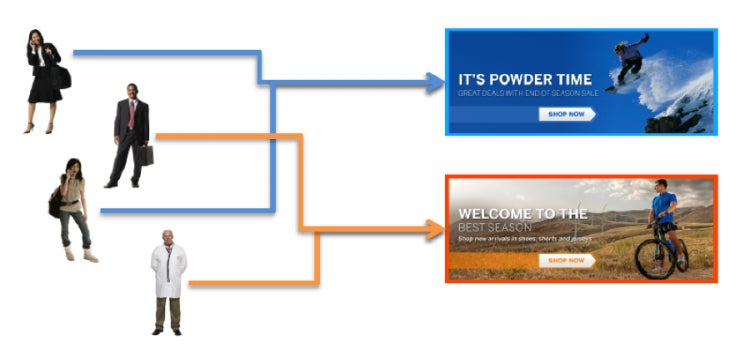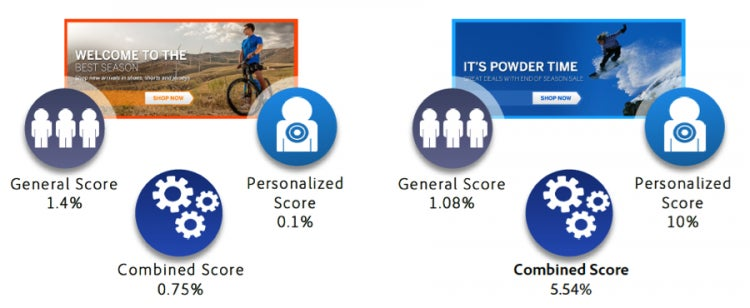How Automated Personalization Works

In my previous blog post, I discussed how visitor data fuels automated personalization. But how does automated personalization use that visitor data to do what it does—match the most relevant experience with a given visitor? In this post, I explain how Adobe Target Automated Personalization works, including the two models it uses and other options and capabilities that impact how it personalizes the individual visitor experience.

http://blogs.adobe.com/digitalmarketing/wp-content/uploads/2014/10/jd4.png
When a visitor comes to a site that has Adobe Target Automated Personalization enabled, before the system serves that visitor any content, it evaluates which experiences that particular visitor is eligible for. This step only occurs if you decide not to give all visitors eligibility for all offers and give Adobe Target Automated Personalization complete freedom to decide which content is shown to which visitors.
Sometimes clear business reasons dictate the need for high-level manual segmentation of visitors, or sometimes you want to use Adobe Target Automated Personalization within your existing segmentation. In such cases, you can define eligibility rules that make specific visitor segments eligible for specific offers.
Let’s look at an example of how a marketer might set up eligibility rules in Adobe Target Automated Personalization:
At a financial institution, when a customer applies for a mortgage and gets turned down, the customer feels disappointed and the institution wastes time reviewing an application that it ultimately had to reject. To limit the customer’s disappointment and reduce the administrative burden on the financial institution, the institution sets up eligibility rules in Adobe Target Automated Personalization. The rules are designed so visitors who are unlikely to qualify for a mortgage are not shown mortgage experiences—for example, customers with low credit scores or annual incomes below a certain level.
If the institution did not specify an eligibility rule, the algorithm would eventually figure out which visitors should see which experiences. However, the eligibility rule gives the marketer more control over the process, allows this high-level segmentation to take place from the onset of the campaign, and allows the models to focus on microsegmentation within each segment—something that would be difficult to do manually.
After determining eligibility, Adobe Target Automated Personalization uses two models to evaluate each experience that the visitor is eligible for: the generalized model and the personalized model.
The generalized model bases its evaluation on the historical behavior of all visitors, not the individual visitor. Think of the output of this model as the historical conversion rate of a particular offer. Returning to our cycling and skiing example from the second post in this series, the generalized scores reflect the overall conversion rate for the experiences across all visitors—1.4 percent for cycling and 1.08 percent for skiing.
The personalized model is built using a state-of-the-art machine-learning platform that uses data about the visitor along with historical data about all visitors to calculate the probability that a particular visitor converts on the experience. In our example below, the visitor is from Salt Lake City. Therefore, he has a low personalized score for the cycling experience because visitors similar to him—those also from Salt Lake City—had low conversion on the cycling experience in the past. Likewise, he has a high personalized score for the skiing experience due to past high conversion numbers for visitors similar to him.
Depending on the maturity of the campaign, Adobe Target Automated Personalization combines the generalized and personalized scores into a combined score in different ways. Right after a campaign starts, it weights the generalized scores more heavily because limited historical data is available for the personalized scores. As the campaign matures, more historical data becomes available, so the personalized scores become more accurate and get weighted more heavily than the generalized scores.

http://blogs.adobe.com/digitalmarketing/wp-content/uploads/2014/10/jd4.2.png
The combined score reflects the predicted probability that the visitor converts on a given experience. The system compares the combined scores for each experience and serves the experience predicted to have the highest probability of resulting in a conversion for that particular visitor.
In our example, Adobe Target Automated Personalization shows the visitor from Salt Lake City the skiing experience because for this visitor, the combined score for the skiing experience is higher (5.54 percent) than the combined score for the cycling experience (0.75 percent). Remember that even though we use location as the sole variable, this is only to add clarity to our example; in reality, Adobe Target Automated Personalization takes into account hundreds of variables.
Now that you understand how Adobe Target Automated Personalization works, you can see that it offers great flexibility. You can rely on it to do all the segmentation—without having to define eligibility rules—or you can define your own eligibility rules or deploy it within existing high-level segmentation. With the first approach, you can easily set up a campaign in a matter of minutes. With the last approach, Adobe Target Automated Personalization can extract that extra-personalized value within already established segments without the need to make any changes to the existing campaign.
Next week I wrap up with my final post in the Power of Automated Personalization series, “Where Adobe Automated Personalization Really Shines.” Read it and discover details about Adobe Target Automated Personalization that enable it to deliver impressive results. In the meantime, I challenge you to think about how you would use Adobe Target Automated Personalization for your campaigns, and which, if any, eligibility rules you would use.